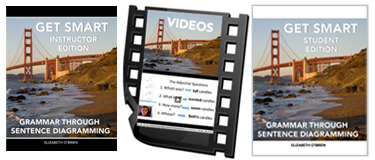Get Smart: Grammar Through Sentence Diagramming is a year-long program that teaches complete sentence diagramming including all eight parts of speech. Get Smart consists of a student edition, instructor edition, and online videos.
Get Smart supplements other grammar instruction since it is not comprehensive. (You also need to teach other topics such as punctuation, correct usage, verb tenses, irregular verbs, and capitalization.) However, it does teach proper sentence structure and usage to some extent as it explores the relationships of words to one another within sentences.
I expect that homeschoolers would use Get Smart alongside another program or method of teaching that does not teach diagramming since it is an efficient way to fill that gap. It might also be used in place of other grammar instruction for a year.
Get Smart begins with simple subjects and verbs, but it quickly moves to complex sentence constructions. For example, week seven teaches about adverbs. In the process, students diagram sentences that include adverbs modifying adjectives rather than limiting instruction to only adverbs that modify verbs. Week 16 has students diagramming compound sentences. Final lessons teach gerund phrases, participial phrases, infinitives, and infinitive phrases. Because the lessons are so comprehensive, I expect that they will work best for students with at least some prior grammar knowledge. That might be a student as young as fourth grade, but it will more likely be students in sixth grade through high school.
Instruction is relatively brief, and it is written in a conversational tone directly to the student: “You remember that nouns are words that name people, places, things, or ideas, right?” (p. 27). Instruction is also available on downloadable videos that come with the course. Videos repeat essentially what is in the book, but they usually expand on it with a little more explanation of one or more examples. Students don’t have to watch the videos if they understand instruction from their book, but some students will appreciate the video presentation. In addition, O’Brien sometimes teaches songs to help students remember information such as the lists of helping verbs or prepositions. She sings songs without accompaniment—it works well even if it’s not professionally recorded.
Throughout the program, the basic method of instruction is fairly traditional—teach the concept then complete practice exercises. However, O’Brien often teaches students to figure out parts of speech and syntax by asking questions, making the exercises more like trying to solve puzzles rather than just memorizing information and filling in blanks.
Sample sentences and other content in the book is very neutral, so the course should be acceptable to all audiences.
The student book is duplicated in the instructor edition but with the answers included along with occasional brief teaching tips. The course is very easy to teach and should take no more than ten minutes per day on all but the first day of each lesson. On the first day, students will be learning a new concept, so you should budget a little more time for those initial sessions for each lesson. But it still should not take longer than 15 minutes. Many students will be able to work independently through even the instructional part of each lesson, especially if they watch the videos.
The 37 lessons in the books can each be spread out over a week, although older students might be able to easily complete two lessons per week and finish the course in one semester. Every fourth lesson consists of comprehensive review with practice exercises plus a quiz. Optional additional sentences to diagram are included in selected lessons. Lesson 38 is a bonus lesson. It presents ten sentences to diagram that have been selected from O’Brien’s advanced diagramming program, Stay Smart.
You can purchase the entire course as a digital download for home use. This allows you to print pages for all students in your family and access videos online. You can choose to purchase a package with printed books that includes access to the online videos. (Videos are not available on DVDs.) For print editions of the books, the reproducible quizzes plus answer keys for the quizzes and optional sentences are all included at the back of the instructor edition. These are included on menus for the digital editions.
Get Smart: Grammar Through Sentence Diagramming seems very practical to me because of its efficiency. Using a resource like this eliminates the need to reteach parts of speech and syntax over and over again. On top of that, the fact that many students can work through this course independently should be a feature appreciated by many home educators.









